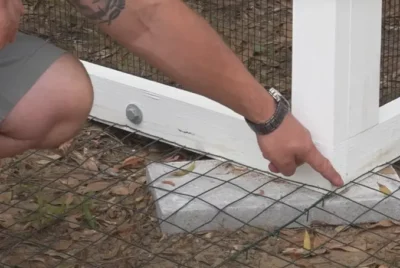Step-By-Step Guide on Building a Predator-Proof Chicken Nesting Box
One way of ensuring the well-being of your chickens, especially your hens, is providing a secure nesting space that is impervious to potential predators.
In this step-by-step guide, we will teach you how to build a predator-proof chicken nesting box to safeguard your feathered friends and their precious eggs.
Table of Contents

Why You Need A Secure and Well-Constructed Nesting Box?
Firstly, a secured chicken nesting box provides a safe and comfortable environment for your hens to lay eggs. A sturdy nesting box ensures the eggs remain clean and protected from predators or environmental factors.
Secondly, it promotes good hygiene, as a well-designed nesting box is easier to clean and maintain, reducing the risk of diseases in your flock.
Additionally, a secure nesting box helps prevent egg-eating behaviors among chickens, as they are less likely to break or peck at their own eggs when they have a designated, cozy spot to lay them.
Read also: Top Reason Why Your Chickens Need a Secure Coop for Safety
How To Build a Predator-Proof Nesting Box
First, gather all the necessary materials for your nesting box project. You’ll need plywood or sturdy wooden boards, screws or nails, hinges, a latch, hardware cloth (wire mesh), a drill, saw, measuring tape, and nesting material such as straw or hay.
Next, design the chicken nesting box based on your needs. Determine the size of the box, typically around 12 inches by 12 inches for each nesting spot, considering the number of chickens you have. Decide on the box’s height and whether you want a hinged lid for easy egg collection.
Now, start building the box by cutting the plywood or wooden boards according to your design. Assemble the pieces using screws or nails, ensuring a sturdy and secure structure for your nesting box.
If you opt for a hinged lid, attach hinges to one side of the lid and the corresponding side of the chicken nesting box. Also, add a latch to keep the lid securely closed when not in use. To provide proper ventilation within the box, drill small holes or install vents near the top.
For predator-proofing, line the interior of the chicken nesting box with hardware cloth, securely attaching it with screws or staples. This prevents predators from reaching through and harming your chickens or eggs.
Now, place the finished nesting box inside your chicken coop or shelter in a secure location, preferably against a wall or corner. Ensure it’s at a convenient height for your hens to access comfortably.
Finally, add nesting material like straw or hay inside the box to create a comfortable and inviting space for your chickens to lay their eggs.
Read also: The Importance of Heavy-Duty Latches in Protecting Your Chickens From Raccoons

Tips for Enhancing Durability and Longevity
Use Quality Materials
Start with sturdy and weather-resistant materials like exterior-grade plywood or treated lumber. Quality materials will resist wear and tear over time.
Seal and Paint
Apply a waterproof sealant or paint to the exterior surfaces of the nesting box to protect it from moisture, UV rays, and the elements. This can significantly extend its lifespan.
Elevate the Box
Place the nesting box on sturdy supports or legs to keep it off the ground. This prevents moisture from seeping in and rotting the bottom of the box.
Predator-Proofing
Regularly inspect the hardware cloth or wire mesh for damage or signs of wear. Repair or replace it as needed to ensure predators can’t breach the box.
Secure Hardware
Tighten screws, hinges, and latches periodically to prevent them from loosening over time. Loose hardware can compromise the box’s security.
Maintain Ventilation
Ensure that ventilation holes or vents remain clear of debris and blockages. Good airflow helps prevent moisture buildup and mold inside the box.
Routine Cleaning
Clean the nesting box regularly to remove dirt, droppings, and old nesting material. A clean environment is healthier for your chickens and prolongs the box’s life.
Use Appropriate Nesting Material
Choose clean and dry nesting material for the boxes. Wet or soiled material can lead to mold and compromise the box’s integrity.
Relocate if Necessary
If the nesting box is exposed to extreme weather conditions or frequent moisture, consider relocating it to a more sheltered area within your chicken coop or run.
Seasonal Maintenance
Perform seasonal maintenance to address any specific challenges your region may face, such as reinforcing insulation during cold winters or providing shade during hot summers.
Read also: Chicken Coop Insulation: Keeping Your Chickens Warm and Predators Out

Additional Safety Measures
- Implementing Perimeter Fencing and Barriers: Installing a strong perimeter fence around your chicken coop or run can be highly effective in deterring predators. Use hardware cloth or welded wire fencing with buried sections to prevent digging predators like foxes and raccoons from gaining access. Bury the fencing about 12-18 inches underground to deter burrowing animals.
- Using Motion-Activated Lights or Alarms: Motion-activated lights or alarms can startle and deter nocturnal predators such as owls, coyotes, and raccoons. Place these devices strategically around the coop and nesting area. The sudden light or noise can scare away potential threats.
- Regular Maintenance and Inspections: Consistent maintenance and inspections are crucial to ensure the effectiveness of these safety measures. Check your perimeter fencing for any holes, damage, or signs of digging regularly. Inspect motion-activated lights or alarms to ensure they function well, and replace batteries as needed. Additionally, inspect the nesting box and its hardware for any vulnerabilities that may have developed over time.
What Is the Ideal Placement of Chicken Nesting Boxes within the Coop?
Typically, nesting boxes should be situated in a quiet, dark, and secluded coop area. This helps create a cozy and private environment, encouraging hens to use the boxes for egg-laying. Placing the boxes off the ground and slightly elevated can also prevent chickens from kicking bedding material into the nests and keep the eggs cleaner.
Additionally, consider locating the nesting boxes near the coop’s entrance or access point so that egg collection is convenient for you. Adequate spacing between nesting boxes is crucial to prevent overcrowding and potential disputes among your chickens.
Proper placement and spacing of nesting boxes contribute to a stress-free and productive egg-laying environment for your flock.

Conclusion
Building a predator-proof chicken nesting box is a rewarding project that helps safeguard your chickens and their eggs from potential threats. By following this guide, you can create a secure and comfortable nesting space that ensures the well-being of your feathered friends while providing you with fresh eggs for years to come.




